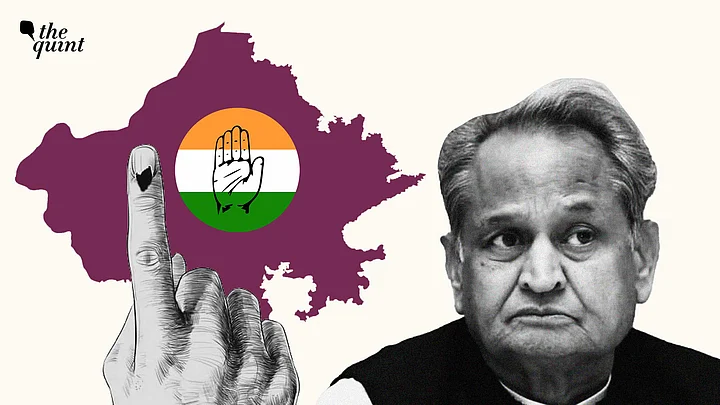The much-awaited exit polls for the Rajasthan election are out and it's a mixed bag.
Contrary to popular expectations of a comfortable BJP victory due to the tradition of alternating governments in the state, three agencies, that is, India TV-CNX, India Today-Axis My India, and News 24-Today’s Chanakya, have predicted a Congress victory, with the latter emerging as the single largest party.
If these three agencies are correct in their assessment, then how has Ashok Gehlot, the jaadugar, turned the tables, given that he was supposedly on the backfoot all this while?
I give 9 reasons for the same.
1. The woman vote: As per Axis, 44 percent of women may have backed the Congress compared to 40 percent behind the BJP.
This shows that the party's scheme consisting of an LPG cylinder worth Rs 500, and the mehangai rahat camps, may have worked on the ground as inflation was indeed one of the top issues in the elections.
While it is leading by 4 percent amongst females, Congress is also trailing by 2 percent amongst males as per the Axis survey.
2. Farmers' protests hit BJP in Shekhawati: Shekhawati, which has 21 seats, is a flip region, swinging between the Congress and the BJP in the last three polls, in line with the overall trend.
However, the Axis exit poll shows that the Congress is in the lead by 5 seats, possibly because the region was a hotbed of farmers' protests. Indeed, agricultural issues dominate this region.
3. ERCP worked for the Congress in Eastern Rajasthan: Dhundhar and Ahirwal are the eastern regions that backed the Congress in 2018. These are also flip regions where the party had won largely due to the backing of the Gujjars, who saw a chance of Sachin Pilot becoming chief minister.
Raising the issue of the ERCP (Eastern Rajasthan Canal Project) seems to be have given the Congress some traction since this has converted into a regional pride issue.
4. Pilot holds Gujjar vote: The BJP was hoping to make significant gains with respect to the Gujjar voters who had switched to Congress in 2018 because of Pilot. Of the 40 Gujjar-influenced seats, Congress had won 24 in 2018, gaining 16 seats.
If these 3 agencies are right, then it points to the fact that Pilot may have been able to keep the Gujjar flock together. The BJP is leading by just 4 percent here, as per Axis, which was not expected at all.
5. Minority consolidation: Polarisation became a big issue closer to the elections, with both sides playing the Hindu-Muslim card.
Muslims seem to have consolidated solidly behind the Congress, that is, 83 percent, as per Axis in 2023, compared to 62 percent as per CSDS (Centre for the Study of Developing Societies) in 2018 (+21 percent). There are 21 seats which have significant minority influence.
6. Welfare schemes: CM Ashok Gehlot recently launched a slew of schemes ranging from Annapurna food packets to the Chirnajeevi scheme, from Urban NREGA (National Rural Employment Guarantee Act) to smartphones, and even free electricity, thereby catering to women, the youth, the farmers, and the poor.
A mix of tangible and soft cash transfers in pensions may have queered the pitch for Gehlot just like it had for Jayalalitha in 2016 in Tamil Nadu.
7. SC-ST consolidation: The Dalits and the Adivasis constitute 31 percent of the state's population and have traditionally backed the Congress. There are 58 reserved seats in Rajasthan of which in 2018, the Congress won 31 and the BJP won 20.
The BJP must have hoped that free ration distribution, a special Rs 24,000 crore scheme announcement for the tribals, and the high crime rate under the SC-ST Atrocities Act during Gehlot's tenure, would sway that votebank towards the saffron party.
However, if the three aforementioned exit poll agencies are correct, then there seems to be a massive SC-ST-Muslim consolidation in favour of the Congress, with Axis showing for them a 22 percent lead amongst the STs and a 31 percent lead amongst the SCs.
8. The poor may have backed the Congress: Gehlot’s schemes seem to have worked for the poor as well; 41 percent of the sample as per Axis, where the Congress is leading by 4 percent against the BJP.
On the other hand, the BJP is seen leading amongst the rich by 8 percent.
Free ration distribution is a central scheme that could pay dividends in the general elections. This also points to a rural-urban divide, with the Congress leading by 2 percent in rural areas (163 seats) and trailing by 4 percent (37 seats) in urban areas.
9. Ashok Gehlot leads the CM ratings: Additionally, Gehlot is not unpopular, leading the CM ratings at 32 percent followed by Baba Balaknath 10 percent.
There is definitely anti-incumbency against Congress MLAs but he seems to have converted the elections into a presidential contest as highlighted in an earlier piece.
To sum up, if, and it's still a big if, Gehlot manages to pull Congress from the jaws of defeat and into the arms of victory, thereby ending the revolving door mechanism, then these nine factors could be the reasons attributable to the same.
(The author is an independent political commentator and can be reached at @politicalbaaba. This is an opinion piece. The views expressed above are the author’s own. The Quint neither endorses nor is responsible for them.)
